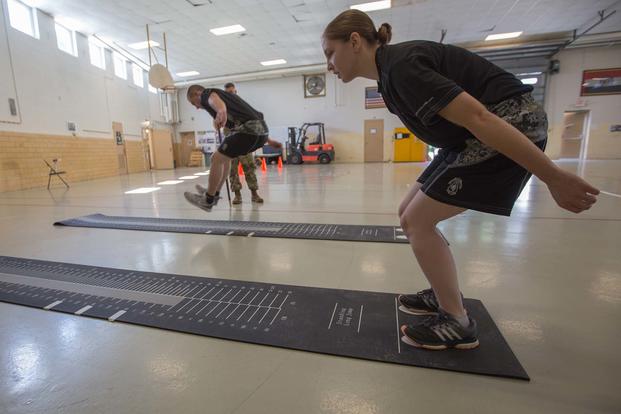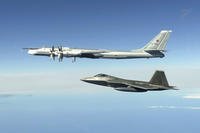In the eight months since the U.S. Army launched the Occupational Physical Assessment Test, recruiting officials now see the test as a critical tool that was missing from the way the service predicts whether recruits can cut it in infantry and other physically challenging jobs.
OPAT is designed to measure muscular strength, muscular endurance, cardiorespiratory endurance, explosive power and speed.
Since OPAT's Jan. 3 launch, 61,673 recruits have passed the test at the appropriate level to proceed into the job on their contract, according to Army Recruiting Command's mid-September numbers. Of that number, 79 recruits did not meet the standard for the job they picked and renegotiated their contracts to select another job.
There were also 13 additional recruits that did not pass the OPAT standards for the job they chose and decided to cancel their contracts with the Army.
Related Content:
- Army Mulls Redesigning Basic Combat Training, General Says
- US Army Unveils New Physical Assessment Test
- Military.com's Army Fitness Spotlight
Before the OPAT, recruits only had to go through that Armed Services Vocational Aptitude Battery, or ASVAB, and a physical examination, according said Col. Jim Jensen, director of operations for Army Recruiting Command.
"This adds that physical aspect to it, to put that person in the right job," Jenson said. "This was a missing piece for us I think for the longest time. ... It's one more touch point for a recruiter with a future soldier. Once again, we are validating putting the right person in the right job."
After selecting a career field and signing a contract, every future soldier must take and pass the OPAT at the appropriate level for the selected career within 90 days of shipping to basic training. They are able to take the test multiple times, if necessary. If they are unable to pass the test at appropriate level, they have the option of renegotiating the contract for another specialty or canceling the contract for service.
OPAT consists of four tests:
The "Standing Long Jump" is designed to assess lower-body power.
The "Seated Power Throw" is designed to assess upper-body power.
The "Strength Deadlift" is designed to assess lower-body strength
The "Interval Aerobic Run," always performed last, is designed to assess aerobic capacity.
Under the new test, job specialties are divided into three physical demand categories:
"Black" for MOSs with heavy physical demands, like those of the combat arms branches that require lifting or moving 99 pounds or more. To attain Black on the OPAT, the recruit or soldier would need to attain a minimum of 5 feet, 3 inches, for the standing long jump; 14 feet, 9 inches, for the seated power throw; 160 pounds for the strength deadlift; and a 10:14 minute mile over the course of 43 shuttles.
"Gray" for MOSs with significant physical demands that require frequent or constant lifting of 41 to 99 pounds and occasional tasks involving moving up to 100 pounds. To attain Gray on the OPAT, the recruit or soldier would need to attain a minimum of 4 feet, 7 inches, for the standing long jump; 13 feet, 1 inch, for the seated power throw; 140 pounds for the strength deadlift; and a 10:20 minute mile over the course of 40 shuttles.
"Gold" for MOSs with moderate physical demands, such as cyber, that require frequent or constant lifting of weights up to 40 pounds or when all physical demands are occasional. To attain Gold on the OPAT, the recruit would need to attain at a minimum, 3 feet, 11 inches, for the standing long jump; 11 feet, 6 inches, for the seated power throw; 120 pounds for the strength deadlift; and, a 10:27 minute mile over the course of 36 shuttles.
Out of the 61,673 recruits, 65 percent scored Black, 21 percent scored Gray and 14 percent scored Gold, Army officials maintain.
About 72 percent of future soldiers meet the OPAT score requirement for their specialty on the first attempt, officials said. And about 92.5 percent of recruits meet the OPAT score requirement for their specialty within the first three attempts.
Some recruits are surprised when they do not perform as well as they thought they would on their first attempt at the OPAT, Jensen said.
"The first time was an eye opener for a few folks," Jensen said, adding that the test helps assess where applicants are physically, so recruiters can give them goals to work on.
"Some people have more strength than others, but they realize what their weaknesses are and then they work on them. We have future soldiers that are in the program up to 14 months, and they can take the test every month until it's time for them to ship."
OPAT has made noticeable difference in the amount of soldiers that complete initial entry training, said Michael McGurk, the director of research for Center of Initial Military Training. McGurk oversees physical fitness in the Army which includes the OPAT.
"When people go to training, we expect so many to pass and so many people not to pass," McGurk said. "I think that we have saved about 1,000 soldiers" that would not have graduated without the OPAT program.
Each recruit that doesn't make it through training equates to thousands of wasted training dollars, McGurk said.
There are many associated costs that go into producing a soldier, including recruiting, transportation, clothing, housing, food and training, McGurk said.
"Every soldier that we put through training costs us between $50,000 and $70,000 ... that's from being on their couch to arriving at their first unit," McGurk said.
"And you save 1,000 soldiers by using this program, that's a lot of money."
The OPAT program will likely be reassessed next year to ensure that the standards for each event are at the right level, McGurk said.
"We believe that sometime probably in fiscal 2018, we will look at them and see if we got them right," he said. "We imagine that if we adjust them in any direction, we would adjust them up not down."
Matthew Cox can be reached at matthew.cox@military.com.






























